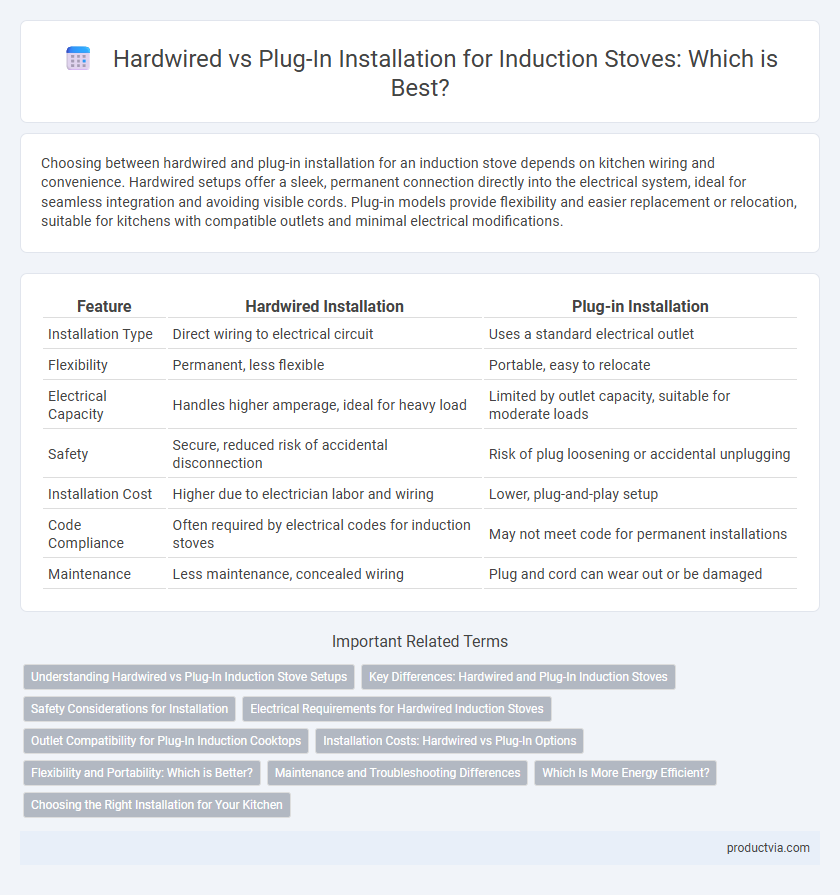Choosing between hardwired and plug-in installation for an induction stove depends on kitchen wiring and convenience. Hardwired setups offer a sleek, permanent connection directly into the electrical system, ideal for seamless integration and avoiding visible cords. Plug-in models provide flexibility and easier replacement or relocation, suitable for kitchens with compatible outlets and minimal electrical modifications.
Table of Comparison
| Feature | Hardwired Installation | Plug-in Installation |
|---|---|---|
| Installation Type | Direct wiring to electrical circuit | Uses a standard electrical outlet |
| Flexibility | Permanent, less flexible | Portable, easy to relocate |
| Electrical Capacity | Handles higher amperage, ideal for heavy load | Limited by outlet capacity, suitable for moderate loads |
| Safety | Secure, reduced risk of accidental disconnection | Risk of plug loosening or accidental unplugging |
| Installation Cost | Higher due to electrician labor and wiring | Lower, plug-and-play setup |
| Code Compliance | Often required by electrical codes for induction stoves | May not meet code for permanent installations |
| Maintenance | Less maintenance, concealed wiring | Plug and cord can wear out or be damaged |
Understanding Hardwired vs Plug-In Induction Stove Setups
Hardwired induction stoves connect directly to the home's electrical wiring, offering a more permanent and secure installation suitable for higher power demands, typically between 30 to 50 amps with 240 volts. Plug-in induction stoves use a standard electrical outlet, usually requiring a heavy-duty plug and compatible receptacle rated for 240 volts, allowing for easier installation and portability. Understanding the electrical specifications and local code requirements ensures proper setup, safety, and optimal performance for both hardwired and plug-in induction stove configurations.
Key Differences: Hardwired and Plug-In Induction Stoves
Hardwired induction stoves connect directly to the home's electrical wiring, offering a cleaner look and reducing the risk of accidental unplugging, while requiring professional installation to meet safety codes. Plug-in induction stoves use a standard electrical outlet, providing easier installation and flexibility to move but may involve visible cords and limited power capacity. Choosing between hardwired and plug-in depends on kitchen layout, electrical system, and personal preference for convenience versus aesthetics.
Safety Considerations for Installation
Hardwired installation for induction stoves offers enhanced electrical safety by minimizing the risk of loose connections and preventing accidental unplugging, which can reduce fire hazards. Plug-in models provide greater flexibility but require high-quality connectors and proper grounding to ensure user safety and compliance with electrical codes. Professional installation and adherence to manufacturer guidelines are crucial for both methods to maintain optimal safety standards.
Electrical Requirements for Hardwired Induction Stoves
Hardwired induction stoves require a dedicated electrical circuit with a specific amperage, typically 40 to 50 amps, to handle the high power demand safely. Installation must comply with local electrical codes and often involves a licensed electrician to ensure proper grounding and circuit breaker compatibility. This setup reduces the risk of electrical overloads and provides a stable power supply crucial for optimal induction stove performance.
Outlet Compatibility for Plug-In Induction Cooktops
Plug-in induction cooktops require outlet compatibility with a dedicated 240V, 30-50 amp circuit to ensure safe operation and optimal performance. Standard household outlets may not supply sufficient power, causing potential electrical hazards or appliance malfunction. It is crucial to verify that the existing outlet matches the stove's plug configuration and amperage requirements before installation.
Installation Costs: Hardwired vs Plug-In Options
Hardwired induction stove installations typically incur higher upfront costs due to the need for professional electrical work and potential panel upgrades, ensuring a dedicated circuit for safety and efficiency. Plug-in models offer lower installation expenses and greater flexibility, as they connect to standard outlets without extensive rewiring. Evaluating local electrical codes and kitchen layout can influence the overall installation cost and feasibility between hardwired and plug-in options.
Flexibility and Portability: Which is Better?
Hardwired induction stoves offer a permanent and stable connection, making them ideal for kitchens with a fixed layout, while plug-in models provide greater flexibility and portability for renters or those who frequently rearrange appliances. Plug-in units can be easily unplugged and moved, supporting versatility without professional installation, though they may be limited by standard outlet power ratings. Choosing between hardwired and plug-in options depends largely on the need for mobility versus a seamless, integrated kitchen setup.
Maintenance and Troubleshooting Differences
Hardwired induction stoves typically offer a more secure electrical connection, reducing the risk of loose wiring issues which simplifies maintenance and minimizes troubleshooting errors. Plug-in models allow for easier disconnection during repairs but may experience more frequent contact-related faults requiring regular inspection. Maintenance for hardwired units often requires a qualified electrician, while plug-in stoves can be serviced more easily by homeowners or technicians due to their detachable power cords.
Which Is More Energy Efficient?
Hardwired induction stoves typically offer better energy efficiency due to a direct electrical connection with minimal resistance and energy loss, unlike plug-in models that may experience slight power drops through the plug and socket interface. Energy consumption in hardwired systems remains stable and consistent, optimizing performance during cooking cycles and reducing wasted energy. For maximizing efficiency, hardwired installation is preferable, especially in high-usage kitchens requiring reliable and consistent power delivery.
Choosing the Right Installation for Your Kitchen
Choosing between hardwired and plug-in installation for an induction stove depends on your kitchen's electrical setup and convenience preferences. Hardwired connections provide a cleaner look and higher power capacity, ideal for built-in stove models requiring dedicated circuits. Plug-in options offer flexibility and easier replacements but might limit power load and require proximity to appropriate outlets.
Hardwired vs Plug-in for induction stove installation Infographic

 productvia.com
productvia.com